Magic in Japan: Guide To Tsukiji Fish Market
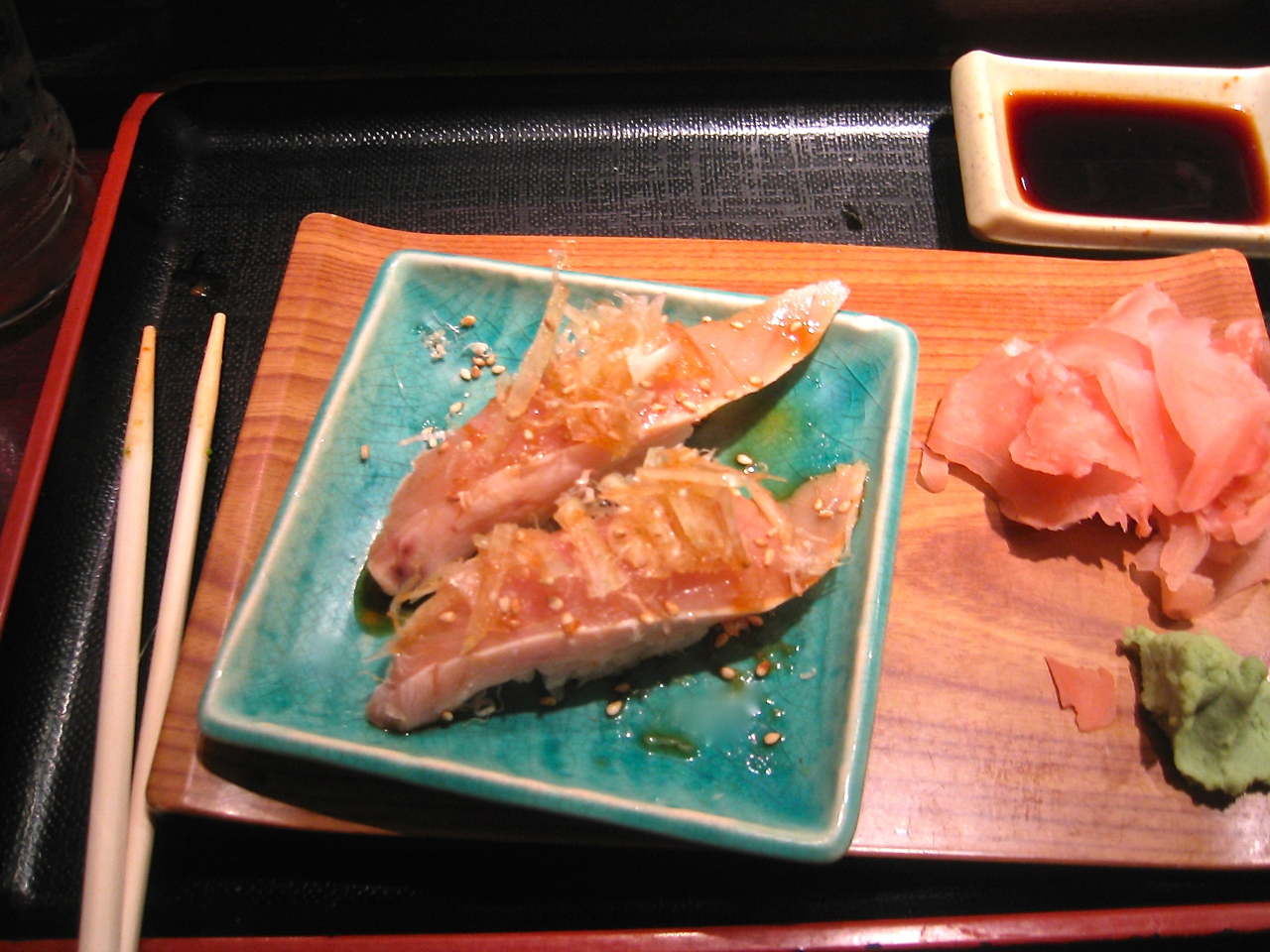
Trip Index:
Introduction
Getting There – JAL First Class
Hotel Review: Ritz-Carlton Tokyo
Guide to Tsukiji Fish Market
Room Service Review: Ritz-Carlton Tokyo
Day in Tokyo
Taking the Shinkansen Bullet Train
Hotel Review: Ritz-Carlton Kyoto
Tea at the Ritz-Carlton Kyoto
Day 1 in Kyoto
Day 2 in Kyoto
Room Service Review: Ritz-Carlton Kyoto
Park Hyatt Tokyo Revisited
Getting to Hiroshima
Hotel Review: Sheraton Hiroshima
Day trip to Miyajima
Day in Hiroshima
St. Regis Osaka
One Day in Osaka
Day in Narita
A Traditional Ryokan Stay
I was wide awake in the pre-dawn hours while many of the other passengers on the subway were not. In fact, despite the bright interior lights and the occasional high-pitched chipper subway announcement most of the compartment appeared to have mastered the art of sleeping until it was their stop.
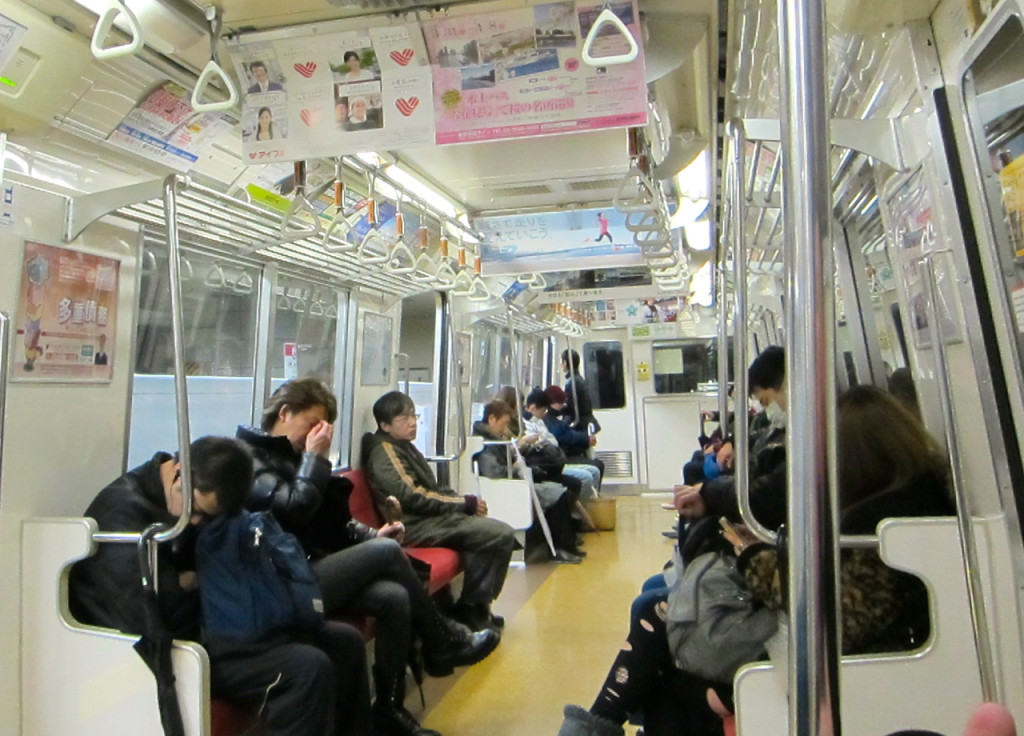
The Oedo Subway line was the most convenient way to get to the Tokyo Metropolitan Central Wholesale Market (Tsukiji Shijo Station), since the main gate of the fish market was right outside the subway station exit A1.

When you think of Tsukiji market, do you automatically think of fish? It’s true that the tuna auction is one of the most exciting activities and the fish market which processes over 2,000 tons of fish each day is one of the largest in the world, but the Tsukiji is actually a wholesale food market with vegetables, fruit, meat and flowers too.
It is believed that the riverside fish market “Uogashi” originated back in the 16th century. In the Great Kanto Earthquake of 1923, dozens of private markets in Tokyo were destroyed, and the city set about to create a central wholesale market. Today, the famous Tsukiji market (ç¯‰åœ°å¸‚å ´) is a don’t miss activity in Tokyo. The fun excursion works especially well for jet-lagged tourists since all the fun starts in the wee early hours of the morn and the action is all over by midday.
The market smell itself was unique, and seemed a lightly pungent mix of fish, seaweed, wood and vegetables. The huge wholesale market has different areas. The inner wholesale ring of fruits, vegetables and fish opens to tourists at 9am, and the outer ring is off limits to all but authorized personnel or those who have been given special permission.
Tourists can watch the tuna auction, and for this you need to arrive early. A maximum of 120 colored vests are handed out first-come first-served to distinguish tourists from wholesalers and buyers, starting at 5am on the first floor at the Fish Information Center. This means, of course, that people are standing in line an hour before then. If you are one of the lucky ones, they’ll then give you a handout as a guide (ie. no flash photos, no disrupting the auction, etc.) and tell you where to find the visitor line.
Meanwhile, in the outer ring, turret trucks wheeled up and down the tiny aisles and shopkeepers were busy unloading and arranging boxes and produce. Starting the night before, the market had been receiving shipments of fresh items from all over the world. I wandered through the hundreds of stalls, taking it all in. There were boxes of fresh, beautiful orchids, cabbage by the bushel, and Mandarin oranges competed for space taken up by enormous boxes of radishes.
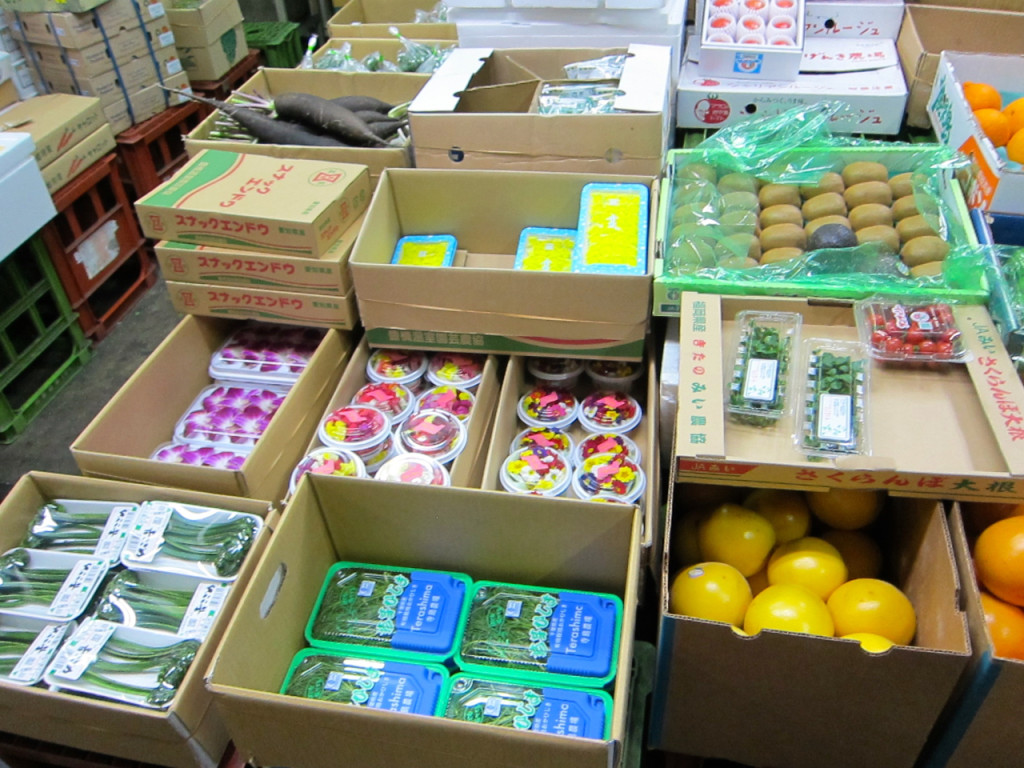
I recognized Chinese cabbage, onion and potatoes easily, but also saw all kinds of vegetables I couldn’t even identify. Prices at the market fluctuate by the day and are affected by the weather, just as all produce prices are.
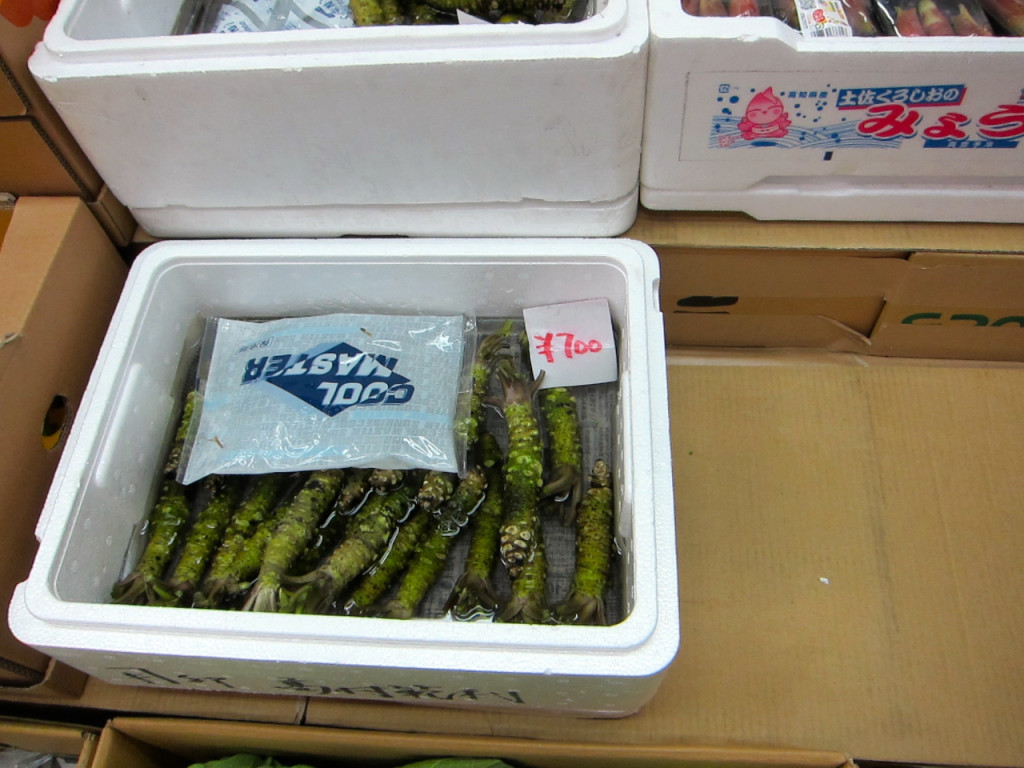 Unfamiliar vegetable (possibly fresh wasabi root per reader Chris)
Unfamiliar vegetable (possibly fresh wasabi root per reader Chris)
I walked carefully from one stall to the next, and it was all mind-boggling to see the sheer volume of items. The huge warehouse was bustling with excitement too. Guys shouted to one another as the turret trucks whizzed by in the dark, and boxes were arranged and tossed around simultaneously with animated conversations.
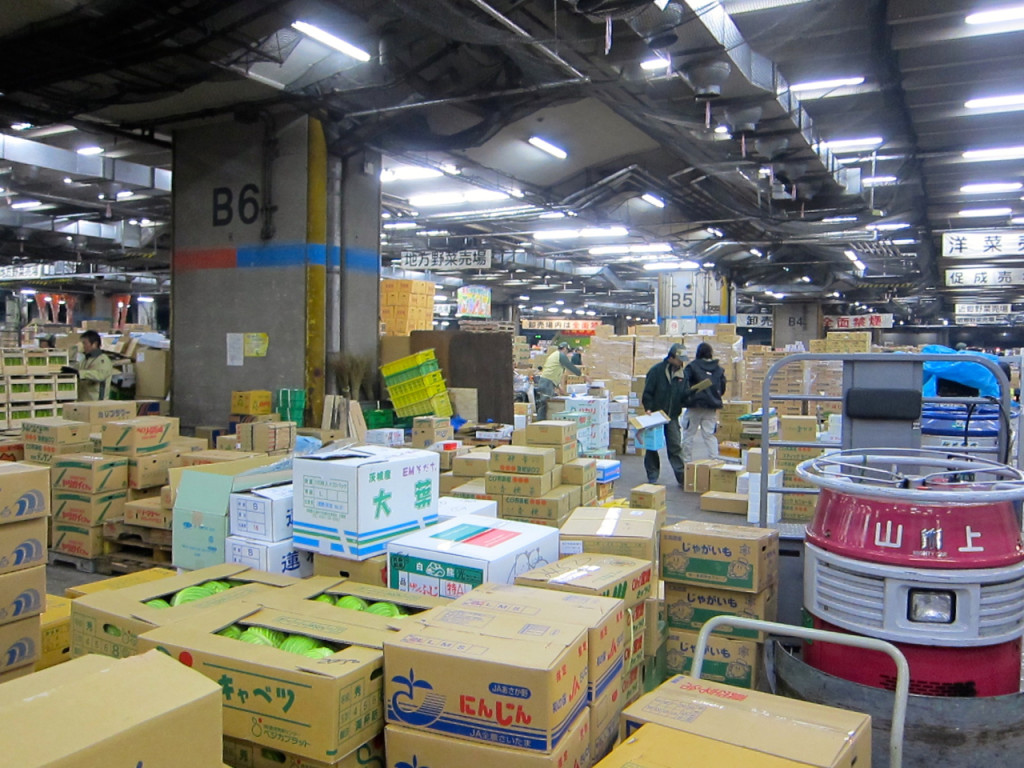
After the vegetables, I found the boxes gave way to huge plastic bins and trays filled with fish. At 330am, wholesalers were already busy laying out their goods in time for the auction. Middlemen scurried through the aisles, checking each item’s quality. The warehouse floor was slick with water and runoff from the produce, and hoses trickling water kept the fish fresh.
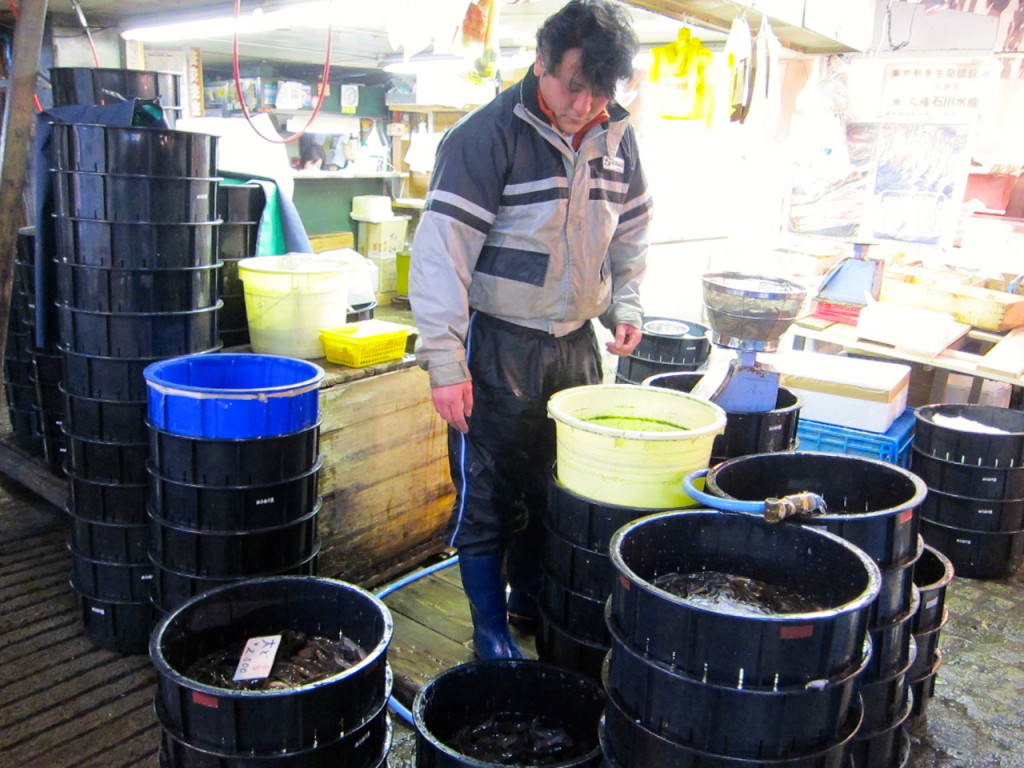 wholesale area
wholesale area
Huge glassy-eyed fish with jaws agape were lined up next to tiny scallops.
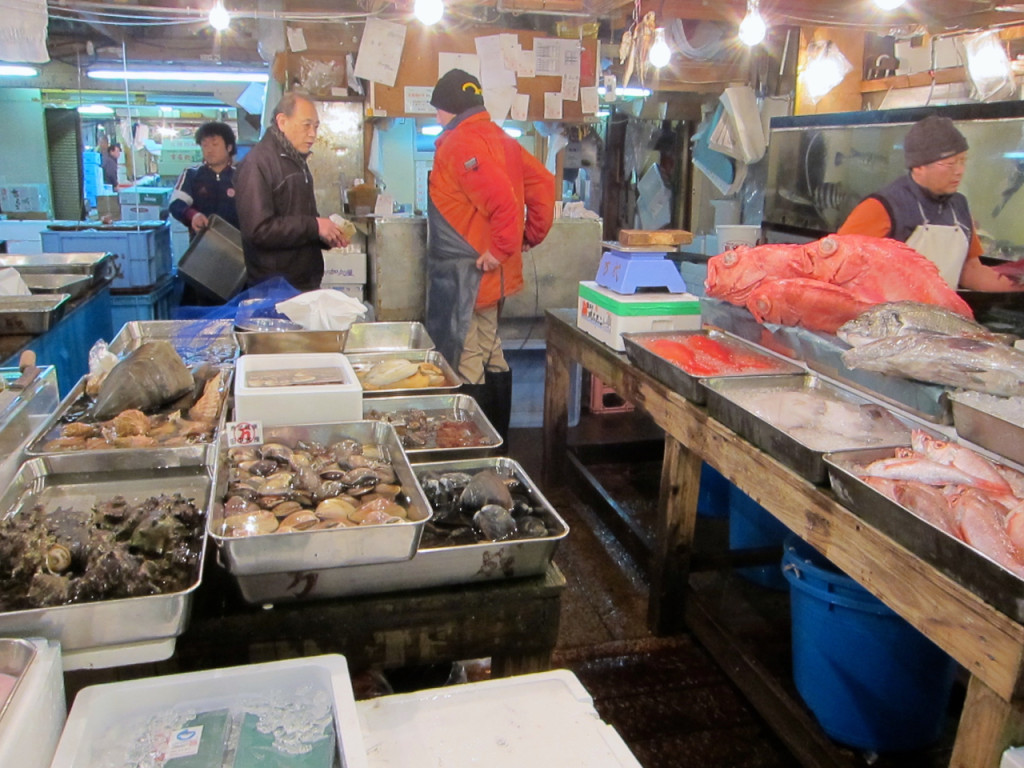 wholesale area
wholesale area
Just before the tuna auction, middlemen carefully inspected and assessed the quality of the lined-up beauties.
At around 5:30am, the auction started. The air was thick with anticipation as middlemen and buyers went up against each other in a fast-paced frenzy of bids.
Here’s a YouTube video of an auction (not taken by me, just fun to watch).
By 7am, the auction was over and the fishmongers took their coveted purchases to their own stalls to prepare them for buyers.
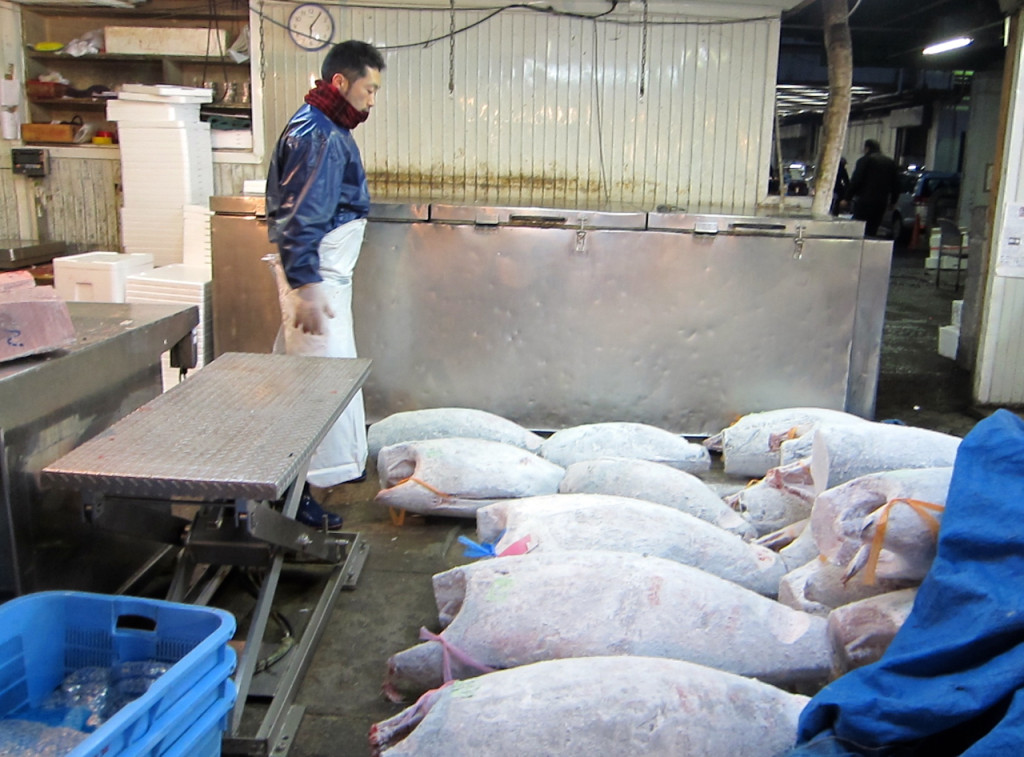
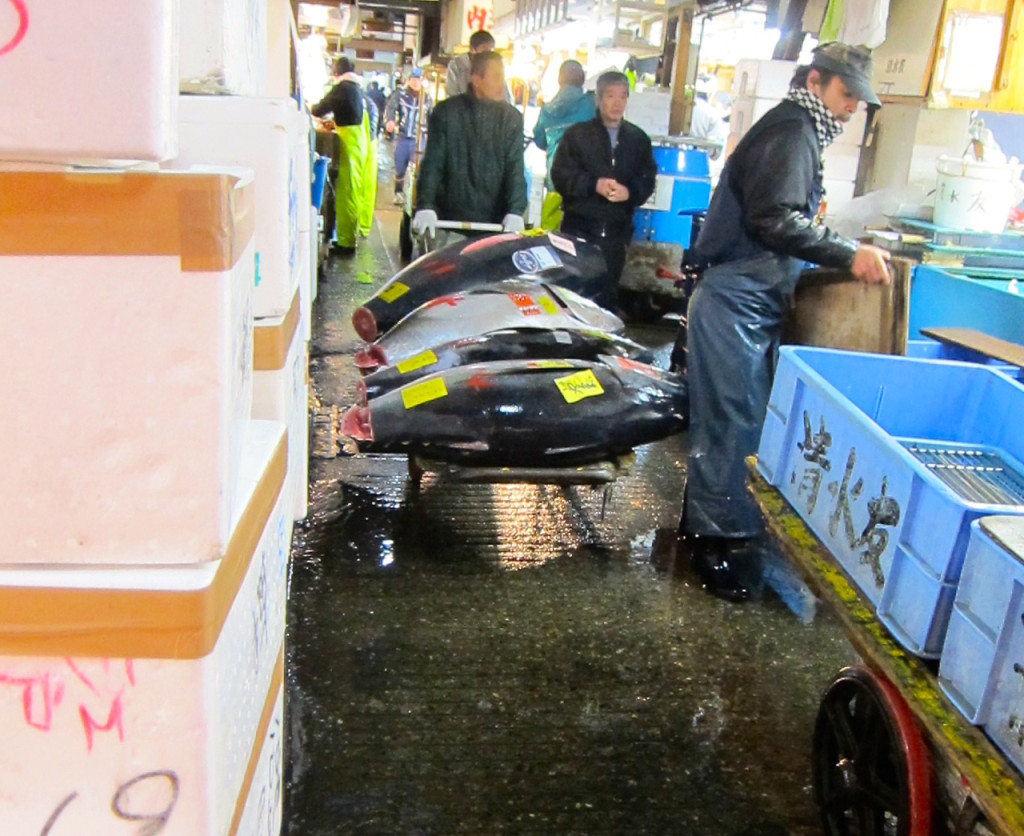
After the auction was over, it was the perfect time to enjoy a fresh sushi breakfast.
There are stalls nearby, but there are also lots of great restaurants just a few blocks away. Sushi Dai and Daiwa-Zushi are some of the most popular, and you can expect to wait in line at either one. Each melt-in-your-mouth piece of sushi will set you back just about ¥800 (7 USD).
8 – 10am is the busiest time in the market (other than during the tuna auction). Tourists, shoppers, middlemen, and retailers all jam into the narrow aisles. The markets that open to the public at 9am have flowers, knives, pottery, and vegetables & fruits in smaller portions than the larger bulk ones meant for wholesale buyers.
Tsukiji Market was never intended to be such a huge tourist attraction, and the market will be moved to a new location around November 2016. The new site will be in Toyosu. *UPDATE 11-30-16* The Tsukiji market move is on hold, and you can find updated information by clicking here.
You can still see the market in action!
Magic of Miles’ tips for visiting –
Go early and try to see the tuna auction
Dress comfortably, with closed-toe shoes
Be respectful
Don’t bring a suitcase or large bags into the market
Be careful, as it can be a dangerous place – slippery underfoot, with hand trucks, tight spaces, knives (for the fish), etc.
Understand that you will not be able to access large parts of the market
The official Shijou Metro Market guide for tourists outlines the process for gaining access to the tuna auction –
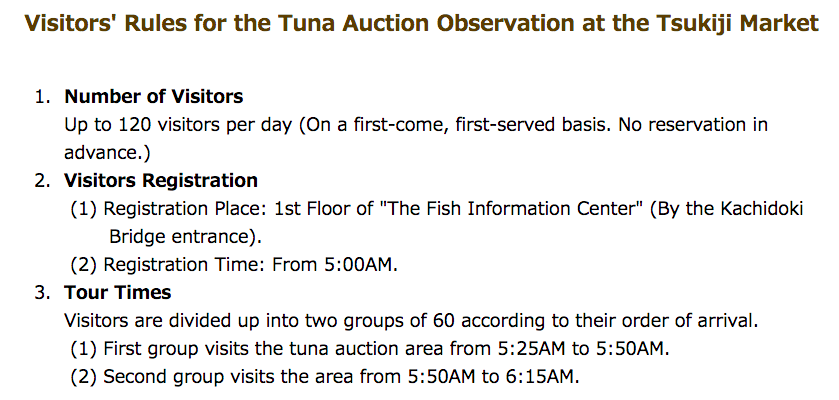
Note that the market is closed on Sundays, national holidays and some Wednesdays. It is also closed to tourists on some of the busier days in the Christmas season (December 4,7,11,18,23,31 in 2016) to make sure that business can continue smoothly and without accidents.
I like this statement that is on the handout given to tourists –

It reminds me that even though the market is a fascinating place, it is a workplace for professionals that are in the business of providing fresh food to locals via wholesalers.
Navigating an unfamiliar market by yourself in the wee morning hours can be a bit daunting. Check out these great popular alternatives via Voyagin, a unique travel experience booking platform based in Japan –
• Tuna Auction and Market Tour with insights from Local Expert
• Morning Private Tsukiji Market Tour
Both highly-rated activities give you the chance to experience the famous Tsukiji market through the eyes of a pro. A guide can be especially helpful if you have kids in tow, and can whisk you through the maze while providing detailed information and tips.
I can’t think of a place where the sushi is more delicious than in Tokyo, plus the Tsukiji market is a fun place to explore too!
Have you been to the Tsukiji Fish Market?
Stay tuned for the next post in the series -Â Room Service Review: Ritz-Carlton Tokyo

I don’t believe that “registration starts at 5am” (for the tuna auction) is accurate. Unless it’s changed in the last 3 years, in April 2011 when I went, all 120 slots were already filled up by 4.45am (we arrived at 4.30am).
Dimples, I know we got in line waaayy earlier than that but referring to the Shijou website it said 5am…perhaps it has not been updated. I definitely agree that readers interested in doing this should be in line well before then. Thanks for pointing this out and for reading!
If you want fresher seafood than Tokyo, then try Hokkaido. Much cheaper, too.
It’s on my list of places to visit, Tony A. Now there’s yet another reason to check it out. I’ll be back in Japan later this year, maybe I can stop by then!
The unfamiliar vegetable looks like fresh wasabi root.
Good to know, thanks Chris! 🙂
We were at the fish market on Tuesday morning! I am typing this from the Park Hyatt Tokyo and we are loving our stay, and this city
How fantastic Bob, and so happy to hear you are having a wonderful time! Stays at the PH Tokyo never last long enough, do they? Thanks for reading
People usually get the set breakfast at the two nigiri places mentioned. And if you aren’t lucky enough to get a yellow vest for the tuna auction, RUN to line up at one of the two tiny restaurants to be first in line. There are only 13 seats at Sushi Dai and it takes about at least 30 -40 mins for each customer to finish the set. So the wait is always long.
Only 13 seats? No wonder the line is so long at Sushi Dai! I’ll do a mad dash if I go again and don’t get a vest, and I’m sure other readers will too. Thanks for the info Ben!
Just a data point for whoever’s reading this. During peak seasons, if you try to queue for Sushi Dai after exiting the tuna auction, the queue can be upwards of 3-4 hours (we queue’d for 4.5 hours in sakura season).
Whoa, 4.5 hours? That’s wild. I hope your nigiri was phenomenal after the wait, and that you savored every delicious bite (even though they try to move people out every 30 minutes or so). 🙂